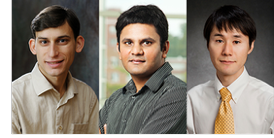Home > Press > Three faculty members awarded 2014 Sloan Fellowships
 |
| Photos of Jain and Ryu by L. Brian Stauffer; Godfrey courtesy of the computer science department
Three University of Illinois professors – from left, P. Brighten Godfrey, Prashant Jain and Shinsei Ryu – have been selected to receive 2014 Sloan Research Fellowships from the Alfred P. Sloan Foundation. |
Abstract:
Three University of Illinois professors have been selected to receive 2014 Sloan Research Fellowships from the Alfred P. Sloan Foundation.
Three faculty members awarded 2014 Sloan Fellowships
Champaign, IL | Posted on February 18th, 2014P. Brighten Godfrey, Prashant Jain and Shinsei Ryu (shin-say ree-you) are among 126 early career scientists and researchers from 61 colleges and universities chosen for a two-year fellowship. In keeping with its goal of recognizing potential groundbreaking researchers in their respective fields, the Sloan fellowship program awards fellows $50,000 to pursue their choice of research topics and allows them flexibility in applying funds toward their research.
Godfrey, a professor of computer science, studies the design and analysis of networked systems. His research group's current projects focus on achieving consistent high performance and low latency in the Internet, verification of network security and correctness, and data center network architecture.
Godfrey earned his doctorate in computer science at the University of California, Berkeley, in 2009, and worked at Intel Labs before joining the faculty at Illinois. He also is affiliated with the department of electrical and computer engineering, the Information Trust Institute and the Parallel Computing Institute, all at Illinois.
Jain, a chemistry professor, investigates the unique behavior of electrons, photons and atoms in nanoscale materials. In particular, his group studies the structure and workings of solid-state catalysts, especially ones that can help clean up toxic gases or that convert sunlight or carbon dioxide into fuels. His group also works with tiny particles with special optical resonances that can be switched on and off. These "plasmonic quantum dots" could act as optical switches - key components for computers that could use light instead of electricity to transmit data - at ultra-high speeds.
Jain earned his doctorate at the Georgia Institute of Technology in 2008, and held postdoctoral positions at Harvard University and the University of California, Berkeley, before joining the U. of I. faculty in 2011. He also is affiliated with the department of physics and the Beckman Institute for Advanced Science and Technology at Illinois.
Ryu, a professor of physics, studies theoretical condensed matter physics, particularly investigating how quantum mechanical effects such as electron entanglement affect electrical properties as electronic devices get smaller. He is also interested in harnessing these effects for quantum computing and novel superconductors.
Ryu earned his doctorate in applied physics at the University of Tokyo in 2005.
Sloan Research Fellowships have been awarded since 1955.
####
For more information, please click here
Contacts:
Liz Ahlberg
Physical Sciences Editor
217-244-1079
Copyright © University of Illinois at Urbana-Champaign
If you have a comment, please Contact us.Issuers of news releases, not 7th Wave, Inc. or Nanotechnology Now, are solely responsible for the accuracy of the content.
| Related News Press |
News and information
![]() Researchers develop molecular qubits that communicate at telecom frequencies October 3rd, 2025
Researchers develop molecular qubits that communicate at telecom frequencies October 3rd, 2025
![]() Next-generation quantum communication October 3rd, 2025
Next-generation quantum communication October 3rd, 2025
![]() "Nanoreactor" cage uses visible light for catalytic and ultra-selective cross-cycloadditions October 3rd, 2025
"Nanoreactor" cage uses visible light for catalytic and ultra-selective cross-cycloadditions October 3rd, 2025
Announcements
![]() Rice membrane extracts lithium from brines with greater speed, less waste October 3rd, 2025
Rice membrane extracts lithium from brines with greater speed, less waste October 3rd, 2025
![]() Researchers develop molecular qubits that communicate at telecom frequencies October 3rd, 2025
Researchers develop molecular qubits that communicate at telecom frequencies October 3rd, 2025
![]() Next-generation quantum communication October 3rd, 2025
Next-generation quantum communication October 3rd, 2025
![]() "Nanoreactor" cage uses visible light for catalytic and ultra-selective cross-cycloadditions October 3rd, 2025
"Nanoreactor" cage uses visible light for catalytic and ultra-selective cross-cycloadditions October 3rd, 2025
Grants/Sponsored Research/Awards/Scholarships/Gifts/Contests/Honors/Records
![]() Researchers tackle the memory bottleneck stalling quantum computing October 3rd, 2025
Researchers tackle the memory bottleneck stalling quantum computing October 3rd, 2025
![]() New discovery aims to improve the design of microelectronic devices September 13th, 2024
New discovery aims to improve the design of microelectronic devices September 13th, 2024
![]() Physicists unlock the secret of elusive quantum negative entanglement entropy using simple classical hardware August 16th, 2024
Physicists unlock the secret of elusive quantum negative entanglement entropy using simple classical hardware August 16th, 2024
Photonics/Optics/Lasers
![]() ICFO researchers overcome long-standing bottleneck in single photon detection with twisted 2D materials August 8th, 2025
ICFO researchers overcome long-standing bottleneck in single photon detection with twisted 2D materials August 8th, 2025
![]() Institute for Nanoscience hosts annual proposal planning meeting May 16th, 2025
Institute for Nanoscience hosts annual proposal planning meeting May 16th, 2025
|
|
||
|
|
||
| The latest news from around the world, FREE | ||
|
|
||
|
|
||
| Premium Products | ||
|
|
||
|
Only the news you want to read!
Learn More |
||
|
|
||
|
Full-service, expert consulting
Learn More |
||
|
|
||








